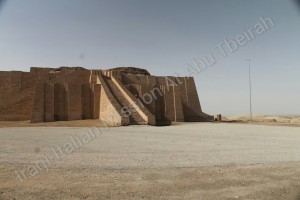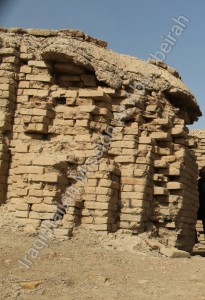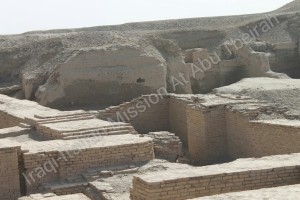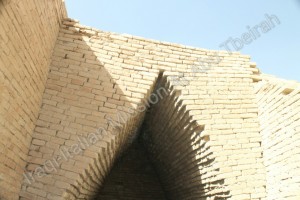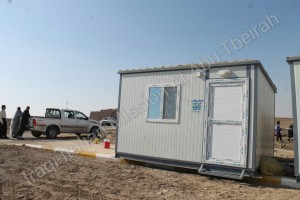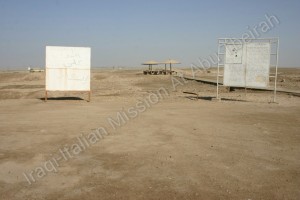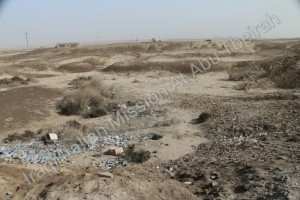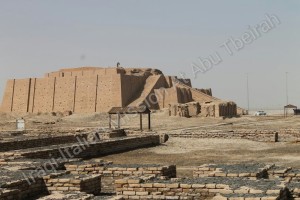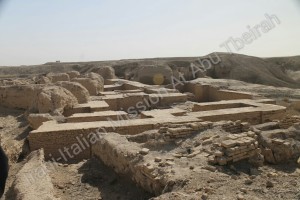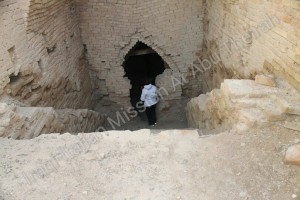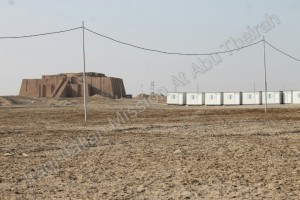Modern Name:
Tell el Muqayyar
Ancient Name :
Ur
Geographic Coordinate:
30° 57′ 45.5508″ – 46° 6′ 10.8000″
30.9626º N – 46.1030º E
Governatorate – District – Sub-district:
Dhi-Qar – Nasiriyah – Ur
Nearest City:
17 km southwest of Nasiriyah.
Chronological Frame:
From Ubaid period (5500-4500 BC) to the Achaemenid Empire (Persian) (until 300 BC).
Excavations:
In 1625, the site was visited by Pietro della Valle, who recorded the presence of ancient bricks stamped with strange symbols, cemented together with bitumen, as well as inscribed pieces of black marble that appeared to be seals.
The site was first excavated in 1853 and 1854 by John George Taylor, British vice consul at Basra from 1851-1859. He worked on behalf of the British Museum. Taylor found clay cylinders in the four corners of the top stage of the ziggurat which bore an inscription of Nabonidus (Nabuna`id), the last king of Babylon (539 BC), closing with a prayer for his son Belshar-uzur (Bel-ŝarra-Uzur), the Belshazzar of the Book of Daniel. Taylor further excavated an interesting Babylonian building, not far from the temple, part of an ancient Babylonian necropolis. All about the city he found abundant remains of burials of later periods. Apparently, in later times, owing to its sanctity, Ur became a favorite place of sepulchers. After Taylor’s time the site was visited by numerous travelers, almost all of whom have found ancient Babylonian remains, inscribed stones and the like, lying upon the surface. The site was considered rich in remains, and relatively easy to explore. After some soundings were made in 1918 by Reginald Campbell Thompson, H. R. Hill worked the site for one season for the British Museum in 1919, laying the groundwork for more extensive efforts to follow. Excavations from 1922 to 1934 were funded by the British Museum and the University of Pennsylvania and led by the archaeologist Sir Charles Leonard Woolley. A total of about 1,850 burials were uncovered, including 16 that were described as “royal tombs” containing many valuable artifacts, including the Standard of Ur. Most of the royal tombs were dated to about 2600 BC. Between them stands out the tomb of a queen, known as Queen Puabi (the name is known from a cylinder seal found in the tomb, although there were two other different and unnamed seals found in the tomb). Many other people had been buried with her, in a form of human sacrifice. Near the ziggurat were uncovered the temple E-nun-mah and buildings E-dub-lal-mah (built for a king), E-gi-par (residence of the high priestess) and E-hur-sag (a temple building).
Outside the temple area, many houses used in everyday life were found. Excavations were also made below the royal tombs layer: a 3.5-metre (11 ft)-thick layer of alluvial clay covered the remains of earlier habitation, including pottery from the Ubaid period, the first stage of settlement in southern Mesopotamia. As a result the ruins of the ancient city attracted many visitors. One of these visitors was the already famous Agatha Christieh
Historical Remarks:
A major Sumerian city, famous for the lavish graves of the Royal Cemetery, the massive Ziggurat, and as capital of the Ur III dynasty.
Ur was a sea-port a and because of marine regression, the remains are now well inland in present-day Iraq. Although the earliest layers at Ur have not been excavated and are known primarily from pottery and tools, the Sumerian King List describes Ur as the seat of several dynasties in the Early Dynastic period . The first would be contemporaneous with the Royal Cemetery (circa 2600 BC) graves, which included Meskalamdug and Pu-Abi, presumably king and queen, which were found laden with magnificent jewelry, weaponry and vessels of gold, silver, lapis, and carnelian, and the graves of hundreds of retainers, soldiers and ladies-in–waiting.
Nanna (Sin, Sumerian for “illuminator”) the moon god, was the patron god of Ur and his high priestess (entu) was a very important office, held by daughters of kings, such as Enheduanna , daughter of Sargon. The Ur III (2100-2000 BC) dynasty built extensively, including a large ziggurat that is the best preserved in Mesopotamia. The temple, a huge stepped platform, was constructed during the 21st century BC by King Ur-Nammu. In Sumerian times the ziggurat was called Etemennigur. Ur was also the traditional home of the biblical patriarch Abraham (Gen. 12:4-5); the city is known in the Bible as Ur of the Chaldees. This biblical name refers to the Chaldeans, who settled the area about 900 BC.
Present situation:
The site is the most easy to be visited by tourists indeed, this is the most famous and most sought-after archaeological area of entire Iraq. Its location, inside a military base since the ‘70s has prevented the looting and during the war of 1991 only minor damages have been reported (none of them visible today) . It was put outside the military area only in 2009 by the American Army which was occupying the Tallil base. With the financial help of the PRT Program system some improvements to the accessibility of the site have been made between 2004 and 2010 (among them the building of a house to welcome tourists, used now by the archaeological teams working in the area, and the creation of a wooden walk-way leading from the Ziqqurat to the Royal Tombs of the Ur III Period which now is being prolonged to the house of Abraham). On occasion of the possible visit of the Pope in the next future, some rehabilitation works are being carried on. First of all in front of the entrance gate a parking area is being prepared, which should welcome the cars of the tourists. A series of prefabricated little laminate white houses has been placed at a distance of 300 m west of the Ziqqurat on a reinforced concrete platform. The visual impact is quite negative and it is strongly recommended to free the area from these structures.
Other structures which do hamper the aesthetic fruition of the monument are represented by electricity poles which run directly in front of the Ziqqurat and by four concrete umbrellas which stand directly in front of the court of Nanna (they were thought as a rest area for tourists but, beyond the ugly impact on the site, they also represent a danger because of their bad conditions of maintenance).
The most important critical aspect for the rehabilitation of the site is represented by the huge.
Other more technical interventions on the archaeological remains are represented by :
1. the cover in concrete of the Edublamah, which was put by Woolley himself in the ’20s, that should be removed and changed with a lighter cover made by perishable material (wood and reeds), easily yearly renewable;
2. the Royal mausoleums of the Ur III dynasty risk to collapse and the structure should be reinforced; moreover, the area is now not easily accessible and risky for the visitors.
Visibility:
The Ziqqurat (2100 BC), over 25 m high, restored by Taha Baqer in the ‘60s (notwithstanding some historical critics, the restoration appears quite impressive to the visitor), and the Dublamakh (1400 BC in its present form), in the East side of the Court of Nanna, represent the best preserved monuments of the site. The Ganunmakh, the plan of the palaces of Shulgi and Amar-Suena (2100 BC), and the House of the Royal Women are visible only in their planimetry. The visit to the Ur III Mausoleums is very suggestive, and of a high religious interest is the stopover in front of the reconstructed and so-called “House of Abraham”.
Nome moderno:
Tell el Muqayyar
Nome antico:
Ur
Coordinate Geografiche:
30° 57′ 45.5508″ – 46° 6′ 10.8000″
30.9626º N – 46.1030º E
Governatorato-Distretto-Subdistretto:
Dhi-Qar – Nasiriyah – Ur
Città più vicina:
17 km a sud ovest di Nassiriya.
Quadro Cronologico:
Dal periodo Ubaid (5500-4500 aC) al impero achemenide (persiano) (fino al 300 aC).
Scavi:
Nel 1625, il sito è stato visitato da Pietro della Valle, che ha registrato la presenza di antichi mattoni decorati a stampo con strani simboli, cementati insieme al bitume, così come frammenti di marmo nero incisi che sembravano essere sigilli. Il sito è stato scavato prima nel 1853 e 1854 da John George Taylor, vice console britannico a Bassora (1851-1859). Egli lavorava per conto del British Museum. Taylor trovò cilindri di argilla nei quattro angoli della terrazza superiore della ziggurat che portava una scritta di Nabonidus (Nabuna`id), l’ultimo re di Babilonia (539 aC), chiudendo con una preghiera per suo figlio Belshar-uzur (Bel- Sarra-Uzur), il Baldassarre del Libro di Daniele. Taylor inoltre scavò un interessante edificio babilonese, non lontano dal tempio, parte di un’antica necropoli babilonese. Su tutta la città trovò abbondanti resti di sepolture di epoche successive. A quanto pare, negli ultimi tempi, a causa della sua santità, Ur divenne il luogo preferito di sepolcri. Dopo il periodo di Taylor il sito è stato visitato da numerosi viaggiatori, quasi tutti hanno trovato resti antichi babilonesi, pietre incise e simili, trovandoli sulla superficie. Il sito è stato ritenuto ricco di testimonianze, e relativamente facile da esplorare. Dopo alcuni sondaggi che sono stati fatti nel 1918 da Reginald Campbell Thompson, HR Hill ha lavorato sul sito per una stagione per il British Museum nel 1919, ponendo le basi per sforzi più ampi da perseguire. Scavi tra il 1922-1934 sono stati finanziati dal British Museum e l’Università della Pennsylvania guidati dall’archeologo Sir Charles Leonard Woolley. Un totale di circa 1.850 sepolture sono state scoperte, di cui 16 sono state descritte come “tombe reali” contenenti molti manufatti preziosi, tra cui lo Stendardo di Ur. La maggior parte delle tombe reali erano datate a circa 2600 a.C. Tra esse spicca la tomba di una regina, conosciuta come regina Puabi (il nome è noto da un sigillo cilindrico trovato nella tomba, anche se c’erano altri due sigilli diversi e senza nome rinvenuti all’interno). Molte altre persone erano state sepolte con lei, in una forma di sacrificio umano. Vicino alla ziggurat sono stati scoperti il tempio E-nun-mah e l’edificio dell’ E-dub-lal-mah (costruito per un re),l’ E-gi-par (residenza della sacerdotessa) e l’E-Hur-sag (un edificio templare ).
Al di fuori del tempio, sono stati trovati molte case utilizzate nella vita di tutti i giorni. Gli scavi sono stati effettuati anche al di sotto dello strato di tombe reali: a 3,5 metri (11 piedi) uno strato spesso di argilla alluvionale copriva i resti dei precedenti insediamenti, tra cui ceramiche del periodo Ubaid, la prima fase di insediamento nel sud della Mesopotamia. Di conseguenza le rovine della città antica ha attirato molti visitatori. Uno di questi visitatori è stata il già famoso Agatha Christie.
Cenni storici:
Una grande città sumera, famosa per le tombe sontuose del cimitero reale , la Ziggurat massiccia, e come capitale della III dinastia di Ur . Ur era un porto di mare e per una regressione marina, i resti sono ora ben nell’entroterra nell’attuale Iraq. Anche se i primi strati a Ur non sono stati scavati e sono noti soprattutto da ceramiche e strumenti, la lista reale sumerica la descrive come sede di diverse dinastie del periodo proto-dinastico. La prima sarebbe contemporanea con le tombe del cimitero reale (circa 2600 aC) che comprendevano Meskalamdug e Pu-Abi, presumibilmente re e la regina, che sono stati trovati carichi di magnifici gioielli, armi e oggetti d’oro, argento, lapislazzuli e cornalina, e le tombe di centinaia di seguaci, soldati e dame di compagnia.
Nanna (Sin, sumerico per “illuminatore”), il dio della luna, era il dio patrono di Ur e la sua grande sacerdotessa (Entu) era una carica molto importante, tenuta dalle figlie dei re, come Enheduanna, figlia di Sargon. La dinastia di Ur III (2100-2000 aC) ha costruito molto, tra cui una grande ziggurat che è la meglio conservata in Mesopotamia. Il tempio, una grande piattaforma a gradini, è stato costruito durante il 21 ° secolo a.C dal re Ur-Nammu. Al tempo dei Sumeri la ziggurat si chiamava Etemennigur. Ur è stata anche la sede tradizionale del patriarca biblico Abramo (Genesi 12: 4-5); la città è conosciuta nella Bibbia come Ur dei Caldei. Questo nome biblico si riferisce ai Caldei, che si stabilirono nella zona circa nel 900 a.C.
Situazione attuale:
Il sito è il più facile da visitare dai turisti, in effetti, questa è la più famosa e più ambita zona archeologica di tutto l’Iraq. La sua posizione, all’interno di una base militare a partire dagli anni ’70, ha impedito il saccheggio e durante la guerra del 1991 solo danni lievi sono stati segnalati (nessuno di loro oggi visibile). E’ stato messo fuori dalla zona militare solo nel 2009 dall’esercito americano che occupava la base Tallil. Con l’aiuto finanziario del sistema di programma PRT sono stati fatti alcuni miglioramenti sull’accessibilità del sito tra il 2004 e il 2010 (tra cui la costruzione di una casa per accogliere i turisti, utilizzata ora dalle squadre archeologiche che lavorano nella zona, e la creazione di una passaggio viale di legno che porta dalla Ziqqurat alle Tombe Reali di Ur III che ora viene prolungato alla casa di Abramo). In occasione della possibile visita del Papa nel prossimo futuro, alcuni lavori di ristrutturazione sono in corso. Prima di tutto di fronte al cancello d’ingresso è in fase di preparazione un parcheggio , che dovrebbe accogliere le auto dei turisti. Una serie di piccoli prefabbricati di case bianche laminate è stata posta ad una distanza di 300 m ad ovest della Ziqqurat su una piattaforma di cemento armato. L’impatto visivo è molto negativo e si consiglia vivamente di liberare la zona da queste strutture.
Altre strutture che ostacolano la fruizione estetica del monumento sono rappresentati da pali dell’elettricità che corrono direttamente davanti alla Ziqqurat e da quattro ombrelli in calcestruzzo che stanno di fronte alla corte di Nanna (si pensava come area di sosta per i turisti ma , oltre l’impatto brutto sul sito, essi rappresentano anche un pericolo a causa delle loro cattive condizioni di manutenzione).
L’aspetto critico più importante per il ripristino del sito è rappresentato dalla quantità enorme di rifiuti.
Altri interventi più tecnici sui resti archeologici sono rappresentati da:
1. la copertura in calcestruzzo dell’Edublamah, che è stato messo da Woolley stesso negli anni ’20 e deve essere rimosso e cambiato con una copertura più leggera fatta da materiale deperibile (legno e canne), facilmente rinnovabile annualmente;
2. i mausolei reali della III dinastia di Ur dovrebbero essere rafforzati a causa del rischio di collasso delle strutture; Inoltre, la zona ora non è facilmente accessibile ed rischiosa per i visitatori.
Visibilità:
La Ziqqurat (2100 a.C.), alta oltre 25 m, restaurata da Taha Baqer negli anni ’60 (nonostante alcuni critici storici, il restauro appare abbastanza impressionante per il visitatore), e le Dublamakh (1400 a.C. nella sua forma attuale), nel lato est della Corte di Nanna, rappresentano i monumenti meglio conservati del sito. Il Ganunmakh, il piano dei palazzi di Shulgi e Amar-Suena (2100 a.C.), e la Casa delle Donne Reali sono visibili solo nella loro planimetria. La visita ai Mausolei di Ur III è molto suggestiva, e di alto interesse religioso è la tappa di fronte la ricostruzione della cosiddetta “Casa di Abramo”.
